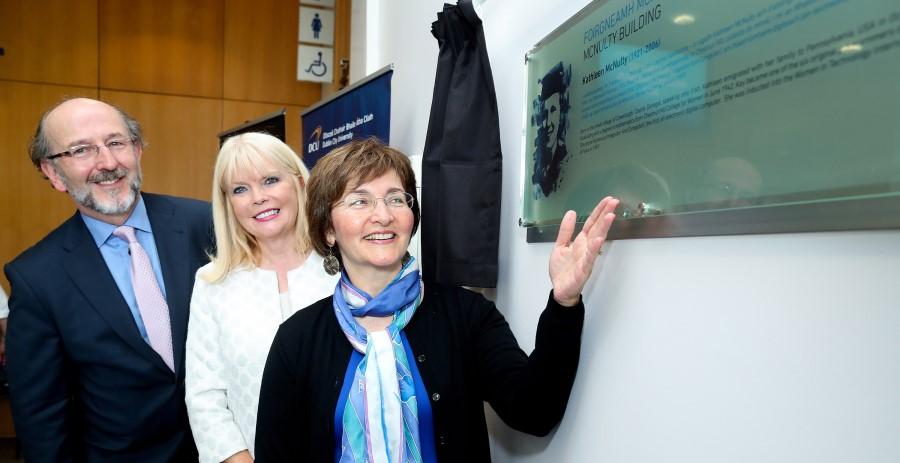

DCU names buildings in honour of Irish female trailblazers
Minister for Higher Education officiates at naming ceremony
Dublin City University has today formally named six buildings after renowned public figures, three being named in honour of Irish female trailblazers in the fields of computing, crystallography and astronomy. Introduced last year as part of the DCU Women in Leadership initiative, Project 50:50 represents a commitment by DCU to name 50% of its major buildings after inspiring female figures.
Ms Mary Mitchell O’Connor TD, Minister for Higher Education was the guest of honour at the event and performed the naming ceremony. In her remarks, she welcomed the DCU initiative to create a diverse, inclusive culture,
“I salute DCU for this initiative and fully endorse it. It is important that our higher education sector represents the diversity and innovation that are at the heart of Irish society. The strongest talent pipeline to meet the future needs of our economy is one which is fully representative of both women and men.”
The Computing Building has been renamed the McNulty Building in honour of Kathleen (Kay) McNulty (1921-2006). McNulty was one of the six original programmers The Donegal-born computer programmer was one of the first programmers of the ENIAC (Electronic Numerical Integrator And Computer), the first general-purpose, electronic, digital computer developed in the US in 1946.
The Postgraduate Student block on the Glasnevin Campus has been named after Mary Brück (1925-2008), born Máire Teresa Conway in Ballivor, Co Meath. The renowned astronomer and astrophysicist conducted widely-published research into stars, the interstellar medium and the Magellanic Clouds, using the numbers, brightness and colours of their stars to study the structure and evolution of nearby galaxies.
Dame Kathleen Lonsdale (1903-71), a crystallographer born in Newbridge, County Kildare, was at the vanguard of establishing crystallography science and determined the structure of the the benzene ring by X-ray diffraction methods, a pivotal milestone in organic chemistry. The Lonsdale Building, which houses the Schools of Chemical Sciences and Biotechnology, has been named in her honour.
Other buildings formally named today include:
the Engineering building, which has been renamed the Stokes Building after Sir George Gabriel Stokes, the Sligo-born polymath who is renowned for many advances in science, including the explanation (and naming) of the phenomenon of fluorescence;
the Marconi Building, named after Guglielmo Marconi, inventor of the radio telegraph system; and
the MacCormac Building which has been named after Michael J. MacCormac, the first Chancellor NIHE Dublin, the precursor of DCU.
Professor Brian MacCraith, President of DCU explained,
“Ireland has made many great contributions to the fields of science and technology through these renowned figures whom we honour today. It is important that we celebrate and look to this rich seam of achievement to inspire current and future DCU students, particularly young women, to emulate the achievements of their predecessors, keeping the STEM tradition alive well into the future.”
Kathleen McNulty’s daughter, Gini Mauchly Calcerano, travelled from the US to be in attendance at the event along with relatives from Kathleen’s home village of Creeslough in Donegal. The family of Mary Brück was also represented by Mary’s brother, Loman Conway and her son, Peter Brück.
